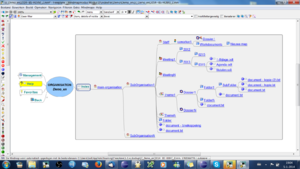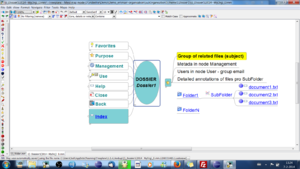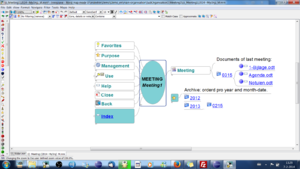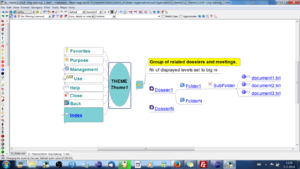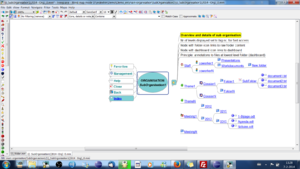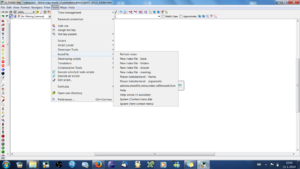Information management withFreeplane add-on dView(indexfile)
Contents
- 1 Introduction
- 2 Folder dashboard
- 3 Dossier dashboard
- 4 Meeting dashboard
- 5 Organizing dossiers and meetings in themes
- 6 Organization dashboard
- 7 Personal dashboard
- 8 Basic dashboard
- 9 Virtual external folders
- 10 Editing file names
- 11 Using IndexFile with Microsoft Sharepoin
- 12 Preferences
- 13 IndexFile Menu
- 14 Translations
Introduction
The add-on IndexFile can copy a folder structure directly into a Freeplane mindmap creating a dashboard with hyperlinks to folders and documents. Folders canto be given a meaning of organisation, theme, dossier, meeting or personal environment by putting an IndexFile of the appropriate index file-type into it. In the index hierarchy generated, an icon is automatically added to each node depict its meaning. Metadata can be added to an index file to describe its content for interpreting the folder's meaning, knowing its confidentiality and decisions to keep or dstroy it. A user may register his e-mail in an index file creating the opportunity to send an e-mail to all registered users at once. The folder hierarchy may be virtually extended with folders at a different location, also if the location itself needs access rights. Filenames can be automatically edited to comply to the structure of the NATO file naming standard. Filenames can be automatically extended with metadata so that filenames keep unique if documents are displaced and combined in a general eDepot or eShare. The following describes use cases for index files.
Go to downloadpage Indexfile to download and install IndexFile.
Folder dashboard
Basically an index file is a mind map which can generate an index hierarchy, like Fig 1, of the content of a folder. This is useful when discussing and improving a folder structure, or when developing a new structure from scratch. The nodes in the hierarchy have hyperlinks to the folders they represent. It is possible to exclude folders with irrelavant inforation, or to stop indexing at a particular folder name. In this way the index file can be used as a dashboard to navigate to information in an easy and fast way, especially if used in combination with Freeplane's find and filter methods. N.B. The dashbaords below also index the files in a folder.
Fig 1. has been generated by storing an index file of type Folder into the main folder. Next the little button of node Index was pressed which ceated the subnodes of Index. If a child node of node Index contains an icon other than the folder icon, this depicts that this folder contains a index file of a particular type (organisation, person, theme, dossier or meeting). Below we will discuss these types.
Dossier dashboard
A folder for a dossier is meant to contain subfolders and documents concerning a particular task or process. In MSExplorer it is not possible to describe the metadata of the dossier-folder. This is the main reason a classic file system is not a document mananagement system. After saving an IndexFile of type Dossier to a (main) dossier folder, you can add the metadata for using an managing the dossier, hence you create your own DMS.
Figure 2a shows a dossier template. In node Management you can put information like the name of the organisation, the email address of the owner (information manager) and status information. This information can subsequently be used to automatically add metadata to document names according to e.g. the NATO statndard for file names. Or by clicking the owner's email icon, you can automatically open an email with the email adress of the owner filled in. In node Users main users and passers by can register their e-mail addresses. Next all registered users can be send a common email by clicking the email icon in node Users. Of course one can add process information for visitors of the dossier, for example in floating nodes which behave like sticky ntes. Node Favorites is meant for keeping links to documents, applications or whatever is important to have at hand when using the dossier. Finally, you could support new users by summarizing the goal of the dossier and adding links to e.g. the three most relevant documents.
Again, the index is generated if the little button of node Index is clicked. Contrary to index node Folder described above, in this case the major folders are displayed above the Index node so you see them right away, see Fig. 2b. Note that documents are displayed with a blue icon "i" and have a hyperlink to open the document. The small button in the document opens a context menu; this is discussed below.
Meeting dashboard
A meeting is a specialisation of a dossier. A meeting folder has years as subfolders and contains subsubfolders with the month and day of a meeting, see Fig.3. The documents of the meeting are contained in the subsubfolders. The index of of its indexfile is called Archive. In addition it has a node Meeting above the Index node. If the small button of the Meeting node is clicked, the Archive node unfolds to show the subsubfolder of the most recent meeting, see Fig.3. It makes sense to use standard, short document names like Agenda and Minutes. In that case freeplane filtering can be used to display e.g. (only) all Agenda documents.
Organizing dossiers and meetings in themes
Basically a theme can be used as a container for dossiers and/or meetings, see Figure 4. If the little button of node Index is pressed, available dossiers and meetings are displayed above node Index. Note in Fig. 4 that these nodes do not have children. This is because dossier- and meeting nodes link directly to their resp. index files. That is they open the dossier/meeting dashboard.
A difference between a dossier and a theme index file might be that the owner of a dossier could be held responsible for the documents contained in the dossier subfolders, while the owner of the theme could be held responsible for the metadata of the theme index file only. Practically a theme is implemented as a dossier with a different icon, so both could be used interchangeably. Like a dossier, a theme can have subthemes.
Organization dashboard
The index file of an organisation implements a dashboard for displaying an organisation with suborganisations, themes, dossiers and meetings. A typical suborganisation is the staff, in which each member could have a personal folder.
When the Index node is clicked, suborganisations, themes, dossiers and meetings are displayed above the Index node, see Fig. 5. Again these items do not have children because the links directly open the resp. dashboards.
Personal dashboard
In general each staff memeber needs a folder/dashboard with handy access to all information needed in dayly work. This folder would contain work in progress not ready to be shared and shortcuts to relevant dossiers and meetings. It could contain favourite hyperlinks to other information or programs too. In this way the staff memeber can do all his work from his personal folder. The index file of type Person provides a dashboard view for this, see Fig. 6. N.B. It is important to know the user can choose to work from the personal folder only or also use his personal dashboard.
Basic dashboard
An index file of type Basic only has an Index node, just like type Folder. It differs from type Folder in that the generated index stops when a folder with a dashboard is encountered (just like the other types) and that is shows files as well. This is useful when having an archive with stable information. For example, in a Meeting archive it makes sense to save this Basic index file as dashboard in each closed year. In that way, if the Index of the meeting is refreshed, only the current information is refreshed. This is much faster then if all folders have to be regenerated.
Virtual external folders
In Fig.6 node Dossier1 displays a second icon signalling that it links to folder whic could be outside the folderhierarchy, on a different disk internet or intranet. The link is created from a shorcut which is dragged to e,g, the personal folder. To be depicted as an index file the shortcut must have a name which is compliant with the name of an index file. Note that a shortcut to an intranet/internet address can be made by dragging the icon in the browser's address field to the folder you want it to be.
Editing file names
When using a dashboard each node with a document link contains a small button. If you press it a context menu of button nodes is displayed. It shows that you can edit the file name, add metadata, or delete the file, see Fig.7. (N.B. These are the only functions of IndexFile which have impact on the files of your folders.)
Making a unique, short file name
If documents are kept within a hierarchy and with index files containing contextual information, document titles can be short indeed. If you would move a document without this context to a different surrounding, its meaning might get lost and there there may be name clashes. In situations like this you can automatically add basic metadata by pressing button Add metadata dossier in Fig. 7. Fig 9. shows that three metadata are added: the name of the dossier, the year of the dossier and the (sub)organisation owning the dossier. All this information is taken automatically from the current index file. If necessary you can edit these data as described for Nato metadata.
Complying to NATO filenaming convention
If you click the button node Add metadata Nato, a date and a classification are added. In Fig.8 the date is taken from the date the document was last modified. The classification "N" is taken from the field classification in the Management node. In this case the management node contains N which means No classification. You can edit the date and classification in the node text and then press button node Rename file to apply it to the real file.
Creating Dashboard names
An index file which is saved with its template name, e.g. (i)_dosier, will not be shown in the generated index. To make these files appear in the Index hierarchy it can be renamed into a dashboard name. An example dashboard name for a dossier is:
- (i)_myDossier(2014--ING-finance)_D
With this name it will appear in the index hiearchy of an index file higher in the folder structure with the icon for dossier (D).
Each time the small button of node Index is clicked, the default dashboard name is added to the clipboard. If you save the Index file and press Ctrl-V (paste), this name is automatically added as a new file name.
The metadata in the dashboard name are useful to find the dashboard, even if a the containg folder is moved to a different location. Once the dashboard is found, also the documents can be navigated to. This is why the documents themselves don't need to have metatdata and can have a short title as a file name.
N.B. In a multilingual environment is possible to have a dashboards for different languales in the same folder. In that case the dashboardname is extended with a two-letter language code, e.g.:
- (i)_myDossier(2014--ING-finance)_nl-D
In preferences this multilangual option can be set.
Sharepoint uses open and closed libraries to store folders and files which can be accessed with read only or write access rights. IndexFile can be used to index these libraries too. Folders with index files could be moved to a Sharepoint library and work there if opened with write access rights. In case of read-only rights, Sharepoint opens a file in a Temporary folder, not in the original environment where the file is stored. This means that relative hyperlinks in Freeplane do not work. A Freeplane Preferences can be set to save links as absolute hyperlinks. These hyperlinks also work in the Temporary environment with read-only rights. <To do: make hyperlinks generated by Index absolute>
Preferences
IndeFile comes with a large number of options which can be set by the user. As an example, the number of files and/or the depth of the folder hierarchie can be preset to some value. This is useful in situations with an unknown, big number of files. For more information, see menu IndexFile > Help.
IndexFile Menu
When IndexFile is installed, menu IndexFile is added to menu Tools. Here you can select the IndexFile Help or one of the templates for Organisation, Dossier etc. Help describes how to implement the use cases described above. If IndexFile is not installed, you can still use IndexFiles created by another user, as they are mind maps. The special functiont like refreshing the Index and triggering a group mail are not active however.
Translations
At present IndexFile is available for English and Dutch. Menu IndexFile > Help contains instructions how you can translate menu's, templates and the Help file to other languages.
